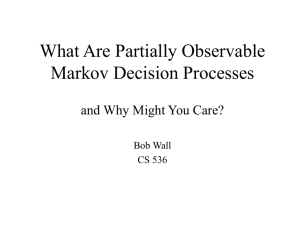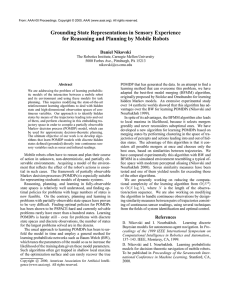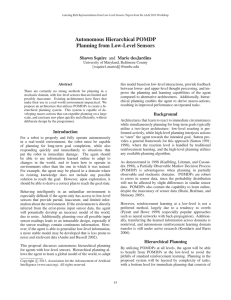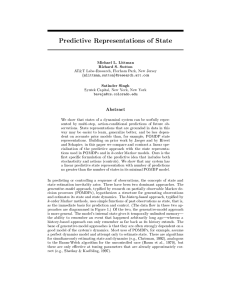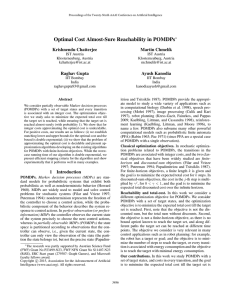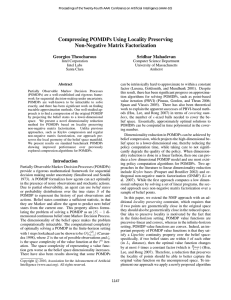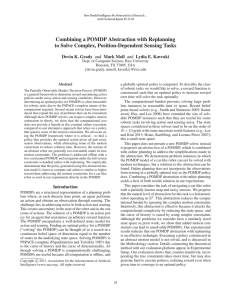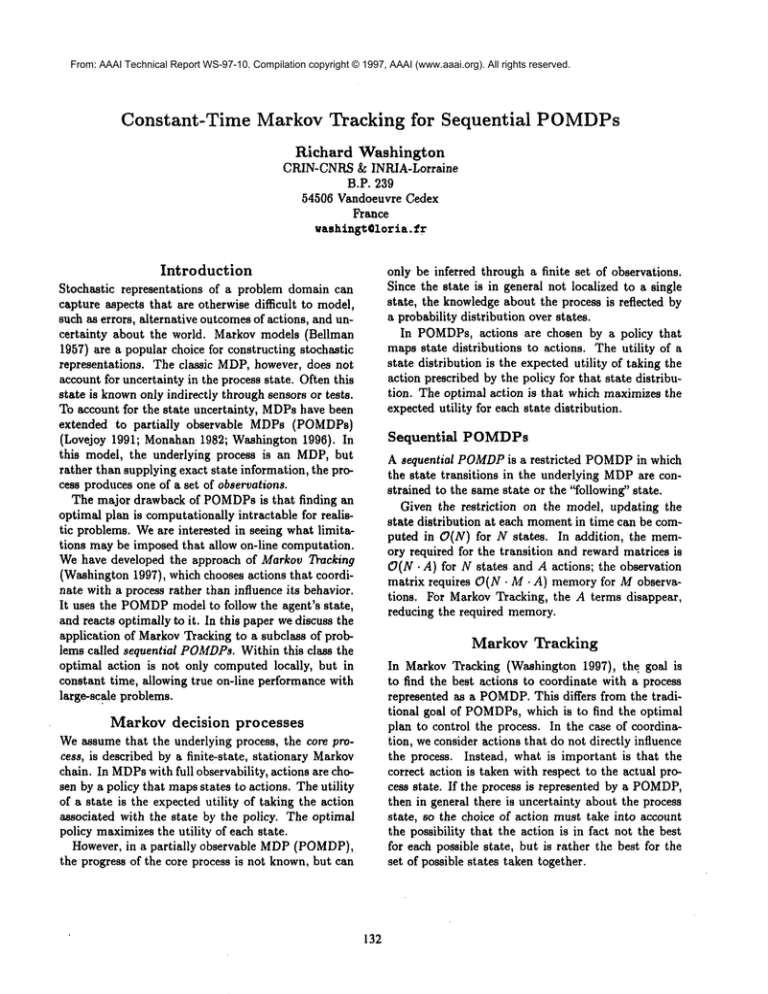
From: AAAI Technical Report WS-97-10. Compilation copyright © 1997, AAAI (www.aaai.org). All rights reserved.
Constant-Time
Markov Tracking
for Sequential
POMDPs
Richard
Washington
CPdN-CNRS& INRIA-Lorraine
B.P. 239
54506 Vandoeuvre Cedex
France
washingt~loria,
fr
Introduction
Stochastic representations
of a problem domain can
capture aspects that are otherwise difficult to model,
such as errors, alternative outcomesof actions, and uncertainty about the world. Markov models (Bellman
1957) are a popular choice for constructing stochastic
representations.
The classic MDP,however, does not
account for uncertainty in the process state. Often this
state is knownonly indirectly through sensors or tests.
To account for the state uncertainty, MDPshave been
extended to partially
observable MDPs (POMDPs)
(Lovejoy 1991; Monahan1982; Washington 1996).
this model, the underlying process is an MDP,but
rather than supplying exact state information, the process produces one of a set of observations.
The major drawback of POMDPsis that finding an
optimal plan is computationally intractable for realistic problems. Weare inter~ted in seeing what limitations may be imposed that allow on-line computation.
We have developed the approach of Markov Tracking
(Washington 1997), which chooses actions that coordinate with a process rather than influence its behavior.
It uses the POMDP
model to follow the agent’s state,
and reacts optimally to it. In this paper we discuss the
application of MarkovTracking to a subclass of problems called sequential POAfDPs.Within this class the
optimal action is not only computed locally, but in
constant time, allowing true on-line performance with
large-scale problems.
only be inferred through a finite set of observations.
Since the state is in general not localized to a single
state, the knowledgeabout the process is reflected by
a probability distribution over states.
In POMDPs,actions are chosen by a policy that
maps state distributions to actions. The utility of a
state distribution is the expected utility of taking the
action prescribed by the policy for that state distribution. The optimal action is that which maximizes the
expected utility for each state distribution.
Sequential
POMDPs
A sequential POMDP
is a restricted
POMDP
in which
the state transitions in the underlying MDPare constrained to the same state or the ’Tollowing" state.
Given the restriction
on the model, updating the
state distribution at each momentin time can be computed in O(N) for N states. In addition, the memory required for the transition and reward matrices is
O(N. A) for N states and A actions; the observation
matrix requires O(N ¯ M ¯ A) memoryfor Mobservations. For Markov Tracking, the A terms disappear,
reducing the required memory.
Markov
Tracking
In Markov Tracking (Washington 1997), the goal
to find the best actions to coordinate with a process
represented as a POMDP.This differs from the traditional goal of POMDPs,which is to find the optimal
plan to control the process. In the case of coordination, we consider actions that do not directly influence
the process. Instead, what is important is that the
correct action is taken with respect to the actual process state. If the process is represented by a POMDP,
then in general there is uncertainty about the process
state, so the choice of action must take into account
the possibility that the action is in fact not the best
foreachpossible
state,
butis rather
thebestforthe
setofpossible
states
takentogether.
Markov decision
processes
Weassume that the underlying process, the core process, is described by a finite-state, stationary Markov
chain. In MDPswith full observability, actions are chosen by a policy that mapsstates to actions. The utility
of a state is the expected utility of taking the action
associated with the state by the policy. The optimal
policy maximizesthe utility of each state.
However, in a partially
observable MDP(POMDP),
the progress of the core process is not known, but can
132
In the POMDP
formalism, the lack of influence of
actions on the underlying process means that the transition from one state to another is independent of the
action, and the observation as well. What remains
to distinguish one action from another is the reward
function. In fact, an action with a greater immediate reward provides a higher overall plan value. This
means that the optimal action, which is the action that
gives the highest value, is in fact in this case the action
with the greatest immediate reward. In the general
POMDP
case, this isn’t necessarily true because of the
difference in transition and observation probabilities.
The way Markov Tracking works is the following. The process transitions probabilistically and provides observations (also probabilistically).
Using the
POMDP
transition function, the current state distribution is updated, and the optimal action is the action
that maximizes the immediate reward for the belief
state.
indicate the evolution of the belief state given no observations, so the tracking process falls back on these
in the presence of "impossible" observations. This allows the model of the process to evolve over time even
in this case. In our experience this allows the process
to re-orient itself quickly.
Discussion
The Markov Tracking approach can be applied to a
number of problem domains. Sequential POMDPsare
appropriate for domains that follow a trajectory over
time. -For example, the computer could have the job
of following a spoken text and producing a subtitled
text to accompany it. Or the computer could have
the job of following a musical score and playing an
accompaniment.
Weplan to investigate these and other ’~eai" applications, but for initial results, we constructed a number
of randomly-generated scenarios to test our ideas. As
expected, accuracy declines with an increase in noise
and unpredictability, but that in general the tracking
method is able to accurately follow the process. In
fact, the errors seem to be mostly local errors caused
by incorrect observations.
The power of Markov Tracking rests on its ability
to take the best action with respect to the uncertainty
of the precise state. So if the observations are generally reliable (as in the generated cases), the results
are generally quite impressive. The tracking method
remains "on course" even in the presence of noise and
a restricted belief state. The size of the windowcan
be altered to handle increasing levels of noise, with of
course an accompanyingincrease in the constant factor
of computation.
Markov Tracking for Sequential
POMDPs
As described earlier, sequential POMDPsare a restricted form of POMDPs
where state transitions lead
to the same or the following state. This class of models can be solved significantly faster if we adopt the
"windowing" method that will be described next.
In POMDPs,the state of knowledge of the current
state of the process is represented by the belief state,
whichis a probability distribution over the set of states.
Over time, this distribution can have many non-zero
but vanishingly small elements, each of which must
be taken into account when updating the belief state.
However, if we limit the distribution to the k most
probable states, by zeroing the rest and renormalizing
the distribution, the computational complexity of the
general POMDP
case reduces from O(N2) for N states
to O(N).
For sequential POMDPs,given a distribution of k
possible states, there are at most 2k states that could
have a non-zero probability in the following time step
(of which k will be retained). This means that the belief state update can be limited to those states, and
in fact that makes the belief state update O(1) (constant).
Note however that there is some risk in limiting the
belief state distribution to a fixed-size window.In particular, it is possible that an observation will be seen
that is in fact impossible in any of the k states (because
it comes from a state that was very improbable but in
fact correct). This results in a null state distribution.
Wepropose the following method to handle this (fortunately rare) occurrence. The transition probabilities
References
Bellman, K. 1957. Dynamic Programming. Princeton
University Press.
Lovejoy, W. S. 1991. A survey of algorithmic methods for partially observed markovdecision processes.
Annals of Operations Research 28:47-65.
Monahan, G. E. 1982. A survey of partially observable Markov decision processes: Theory, models, and
algorithms. ManagementScience 28(1):1-16.
Washington, R. 1996. Incremental Markov-model
planning. In Proceedings of TAI-96, Eighth IEEE International Conference on Tools With Artificial Intelligence.
Washington, lq.. 1997. Markov tracking:
on-line coordination. Draft paper.
133
Optimal,

